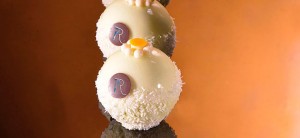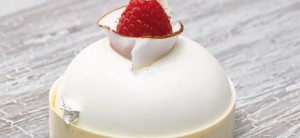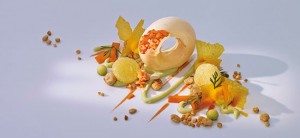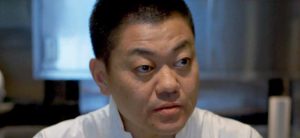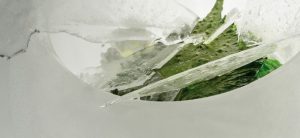Noir by Scott Green
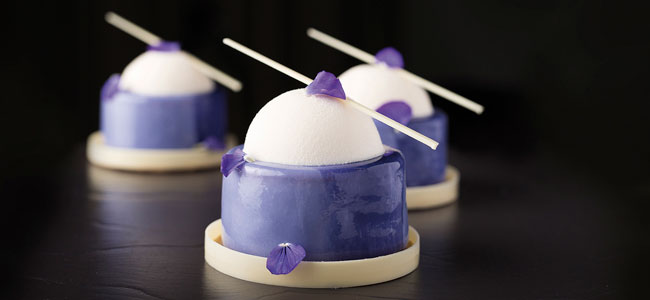
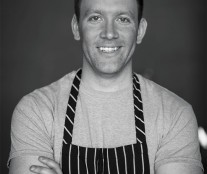 The executive pastry chef at the helm of The Langham Hotel in Chicago, Scott Green, has gone through several phases in his professional and personal life before crossing paths once again with so good.. magazine to share some of his latest creations. If in the previous issue we found him about to participate in the Coupe du Monde de la Pâtisserie (Lyon), from which he took a creditable third place alongside Josh Johnson and John Kraus, this time we dare say his situation is almost the opposite. If last year there were trips, meetings and team trainings happening, at the moment, working in the kitchen dominates, overseeing the production of each new menu or banquet with his pastry brigade. And of course he is very happy with this change. His body asked for a reduction of the workload by taking on a pastry chef’s line of work. But just because the workload is reduced does not mean that life is less stimulating, on the contrary.
The executive pastry chef at the helm of The Langham Hotel in Chicago, Scott Green, has gone through several phases in his professional and personal life before crossing paths once again with so good.. magazine to share some of his latest creations. If in the previous issue we found him about to participate in the Coupe du Monde de la Pâtisserie (Lyon), from which he took a creditable third place alongside Josh Johnson and John Kraus, this time we dare say his situation is almost the opposite. If last year there were trips, meetings and team trainings happening, at the moment, working in the kitchen dominates, overseeing the production of each new menu or banquet with his pastry brigade. And of course he is very happy with this change. His body asked for a reduction of the workload by taking on a pastry chef’s line of work. But just because the workload is reduced does not mean that life is less stimulating, on the contrary.
 Pavilion. The Langham Hotel in Chicago
Pavilion. The Langham Hotel in Chicago
Heading the pastry station at a resort such as The Langham, with a first-class restaurant, Travelle, Afternoon Tea service, ice cream kiosk (Parlour at The Pavillion) and intense banquet activity, the great challenge is to ‘solve problems’, as Scott himself likes to define his work. Achieving lovely results that are also well-balanced in the combination of flavors, textures and intensities, but above all feasibly integrated in specific menus or services. That is his daily challenge, ‘solving problems’ is what makes him happiest. And for that he combines the two dimensions that are fundamental to his professional philosophy: art and science.
Understanding the whys
Scott Green remembers his time at the French Pastry School, alongside the great Jacquy Pfeiffer and Sébastien Cannone. Then, while strengthening his bases and foundations closely linked to the French pastry tradition, he began to work as a teacher giving a new dimension to his knowledge, to some extent forced by his students. Not only did he know and explain how to make each creation, each technique, but he also had to learn the reason why, satisfy students’ curiosity and, thus, further expand the scope of his abilities.
His time as professor solving the ‘whys’ also came to an end. For Scott, theory was just as important as practicing, and preparing products which end up in the mouth of a customer who will enjoy it. This is how he ended up in his current destination in Chicago. There he had the opportunity to join two of his main dimensions, science and art.
Savoir Faire and an American point of view
Science, knowledge, theory and technique are fully connected to his time at the French Pastry School. But if his knowledge is French, his gaze is fixed on American tradition and culture. The great classics of American patisserie, the public’s favorite combinations in their environment, are the subject of his work in a revision through a theory that lightens and sharpens each result.
And then there’s the art, to which Scott Green refers to his past as an artist. A concern for expressing forms and objects with which to seduce the outsider has been present in his life. Currently, patisserie is the perfect discipline for him to continue captivating where once this was done with sculpture or paintings. Either on a plated dessert, a cake or an artistic sugar figure, it is always important to draw the guest’s visual attention, as a beginning and warning of a tasting experience which is to be seen.
Balance and context
As a result, science, the knowledge of technique, is a fundamental aspect. But his aesthetic concerns are only part of the work to be performed. Obviously working with flavors is another great aspect to consider. The combination of easily recognizable, intense yet balanced flavors, playing with acidity, crunchiness or sponginess, which tend to be present in varying intensities.
But there is still another critical factor to attend to in his daily work to ‘solve problems’, and that is to fit every creation in the place where it is intended, either in the Afternoon tea proposals, a themed banquet or at the end of a more or less loaded menu. All without losing sight of the common production system and the need to integrate into it.
Creativity, better with limits
These are the challenges that Scott Green likes confronting. And although adding some limits and problems are an obstacle to creativity, this chef is of the opinion that absolute freedom is not always the best fertilizer for a good result. Therefore he moves in this kind of challenges, this is why he likes to focus on combinations and proposals that have long worked and offer new versions and adaptations. A good example of this is these creations he shares with us now. Some, such as Noir, come from the Afternoon Tea service and originally was an éclair with a delicious blackberry jam as its filling. Or the case of Sonya is another challenge, turning a creation that worked very well with pistachio, lime and cherries to that of a shop window cake.
Noir
sablée
- 370 g butter
- 240 g powdered sugar
- 5 g salt
- 3 g pectin X58
- 125 g whole eggs
- 675 g pastry flour
Cream butter, powdered sugar and salt. Add whole eggs and mix until emulsified. Add pastry flour and mix until homogenized. Bake at 165ºC (330ºF) for 9-15 minutes.
blackberry mousse
- 500 g blackberry puree
- 16 g gelatin
- 500 g cream
- 186 g whites
- 500 g sugar
- 125 g water
- 12 g lemon juice
Bloom gelatin in cold water. Whip cream to soft peaks and reserve. Combine sugar and water and cook to 121ºC. Pour sugar syrup over whites while whisking and whip to stiff peaks. Add bloomed and melted gelatin to blackberry puree and let thicken, whisking often. Scale 200 g of Italian meringue and fold into blackberry puree. Fold in whipped cream.
black fruit jam
- 125 g IQF (Individually Quick Frozen) blackberry
- 125 g IQF wild blackberry
- 125 g IQF black currant
- 105 g sugar A
- 20 g sugar B
- 3 g agar agar
- 20 g lemon juice
Combine IQF fruit and sugar A and heat. Combine sugar B and agar and rain into mixture. Bring mixture to a boil. Add lemon juice. Robot briefly to obtain desired texture.
violet mousse
- 253 g whole milk
- 214 g heavy cream A
- 12 g vanilla
- 197 g sugar
- 283 g egg yolks
- 24 g gelatin
- 121 g water
- 788 g heavy cream B
- 13 g violet extract
Bloom gelatin in cold water. Whip cream B to soft peaks and reserve. Combine whole milk, heavy cream A, vanilla, sugar and yolks and cook to 82ºC. Add bloomed gelatin and whisk well. Cool mixture to 30ºC. Fold in whipped cream and violet extract.
violet crémeux
- 1080 g heavy cream
- 21 g vanilla
- 270 g sugar
- 360 g egg yolks
- 9 g gelatin
- 3 g salt
- 12 g violet extract
Bloom gelatin in cold water. Combine heavy cream, salt and vanilla and bring to a simmer. Combine yolks and sugar and whisk well. Temper yolks into cream and cook to 85ºC. Add violet extract.
vanilla cake
- 540 g cake flour
- 16 g baking powder
- 8 g salt
- 324 g milk
- 360 g egg whites
- 48 g vanilla
- 453 g butter
- 740 g sugar
Bring whole milk, egg whites and butter to room temperature. Combine butter, vanilla and sugar and cream. Combine egg whites and whole milk. Combine and sift dry ingredients. Add wet and dry ingredients alternately to butter mixture. Bake at 180ºC (350ºF), 18-20 minutes.
white chocolate glaze
- 510 g whole milk
- 165 g glucose
- 15 g gelatin
- 607 g white chocolate
- 607 g white paté à glacer
- q.s. purple food coloring
Bloom gelatin in cold water. Combine whole milk, glucose and purple coloring and bring to a boil. Pour mixture over chocolate and pate a glacer. Add gelatin and hand blend. Use glaze at 30-35ºC.
Assembly
Roll sablee to 3 mm thick and cut using 100 mm ring. Bake and reserve. Cast black fruit jam half way into demi-sphere silicone mold. Freeze, unmold and reserve. Cast violet mousse into demi-sphere silicone mold and insert frozen jam. Freeze. Punch 60 mm rounds of vanilla cake. Cast black fruit jam into 60mm round flexi. Cast violet crémeux over black fruit jam and chill until slightly set. Place vanilla cake round onto violet crémeux and freeze. Line 80mm ring with acetate and fill with blackberry mousse. Place cake insert into center of blackberry mousse and freeze. Unmold mousse and glaze. Place glazed mousse cake onto center of baked sablée. Unmold demi-sphere of violet mousse and spray with white chocolate spray. Place demi-sphere on top of the glazed blackberry mousse.
You will find two other very special creations in so good.. magazine #14.
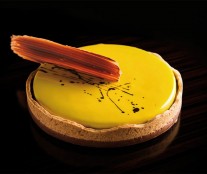 Cabana
Cabana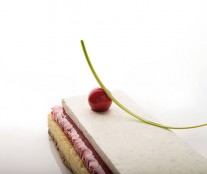 Sonya
Sonya